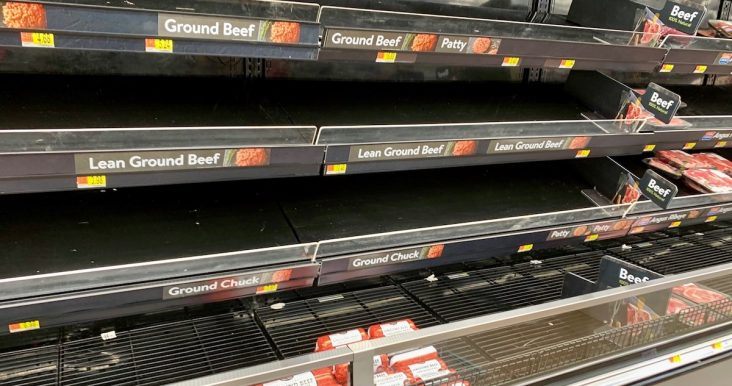Response to meat shortage in grocery stores not an easy fix
by March 25, 2020 12:26 pm 6,236 views

The fresh meat cases at local grocery stores are almost bare any given day as consumers have stockpiled hamburger meat, roasts and other cuts of beef for the past two weeks.
Tyson Foods and other processors are already running plants at near capacity, but the Springdale-based meat company this week is offering farmers additional money for cattle to slaughter as demand at retail is unprecedented, according to Steve Stouffer, president of Tyson fresh meats.
Cargill said this week it’s paying employees in slaughterhouses in the U.S. and Canada an additional $2 per hour until May 3 with a $500 bonus to those who complete weekly shifts over eight consecutive weeks.
Derrell Peel, livestock marketing specialist for Oklahoma State University, told Talk Business & Politics grocery store meat cases are bare because retailers typically order their boxed beef products weeks in advance of delivery. He said when the supply in stores was picked clean, that left a gap that could not be immediately filled.
He said although grocery store meat cases are bare, foodservice cases are full. Peel said the problem is there are two distinct supply chains for beef, one that serves foodservice – primarily restaurants – and one that serves retail. The same is true for chicken. He said there is not a shortage of meat in this country, but the supply chain challenges and logistics are at the heart of the shortage in grocery stores.
“In this country about half of the beef that is produced goes into foodservice to restaurants, schools and institutions. The other half goes to grocery retailers. While restaurants don’t need as much product now, many of those cuts are not the products sold at retail. Restaurants are likely canceling orders and retailers are trying to get more product but it’s not easy for plants to retool and change their production lines,” Peel said.
Having spoken with some foodservice operators, Peel said their business is off by 70% from just two weeks ago. Peel said this segment of the beef supply chain is the most likely to be the hardest hit. He said the suppliers and further processors such as those portion control steak cutters who sell cuts in bulk are already experiencing a downturn.
He said very few grocery stores have butchers and they order boxed beef (case ready) that comes frozen and is unpacked in the back of the store and put into cases for shoppers to buy. He said plants running case-ready beef products are maxed out at capacity. Peel said beef sitting in cold storage is also not a help because it’s largely trimmings used in ground hamburger. He said it’s not product that could go directly to the grocery meat case.
Peel said there is only so much beef consumers can freeze or eat. He said consumers filled freezers and now they can only buy to replace what is eaten. He expects demand for retail beef will begin to subside in the coming weeks. He said if the shutdown and social distancing last more than a few weeks, processors will have to get creative on how they divert beef from foodservice and toward retail. On the backside of this crisis, he said, if freezers are still full there will be a pullback from customers and prices will fall at retail and then reverberate down the supply chain.
Peel said poultry has a short lifecycle and it’s easier for processors to control supply. But he said chicken sold in foodservice is a different size bird than what is sold into retail. He said small birds are sold into foodservice usually in bulk packaging which is different from the case-ready large bird pieces sold in retail.
Tyson Foods is in the process of moving some production from foodservice into retail for its chicken customers. Peel said that is likely an easier move than with beef. He said chicken in cold storage is mostly paws and pieces sold into export markets. Peel said.
“We were counting on good demand this year and meat production has not really increased year over year. Right now domestic demand is strong, but internationally there are challenges from shutdowns due to coronavirus. We are likely in a global recession and that could linger through the third quarter. Processors are having to pull out the stops now to try and recover from this demand shock,” Peel said.
